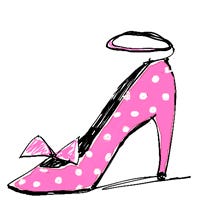The Transformation of Pink: From Playful to Powerful
Written on
Chapter 1: A Colorful Journey
The color pink has a storied past, once seen as whimsical and now embraced by many as a symbol of empowerment. A personal anecdote highlights this evolution: when my sister saw my hot pink dress, she grimaced, calling it “bimbo pink.” However, instead of feeling trivialized, I experienced joy, femininity, and strength.
Historically, pink was synonymous with lightheartedness. Madame Pompadour, the influential mistress of Louis XV, established pink as a hallmark of rococo elegance. The elite donned pink silk and drank from pink porcelain, associating the color with the frivolities of the French court.
In earlier times, pink was not confined by gender norms; it was common for boys to wear pink, regarded as a softer version of red, while girls typically sported sky blue, symbolizing purity.
However, societal shifts following World War II altered these perceptions. As women were directed back into domestic roles, pink morphed into a symbol of femininity, and boys began to favor blue.
The 1950s marked a peak in pink's popularity, as Life Magazine declared 1955 the “Peak Year for Pink.” This era saw pink infiltrating everything from bathrooms to Elvis Presley’s Cadillac, with iconic figures like Marilyn Monroe popularizing pink dresses.

First Lady Mamie Eisenhower’s affinity for pink led to the creation of a shade named after her. Conversely, during Nazi Germany, pink took on a darker connotation, marking the oppression of homosexual men with the pink triangle. This association painted pink as a color of emasculation, distancing men from its perceived femininity.
Yet before these gendered associations, pink held connotations of eroticism. In Europe, it was linked to sexuality, with streets named after flowers, like Rose Alley, hinting at its deeper meanings.
In the 1980s, a surge in crime led prison authorities to experiment with pink, believing it could pacify aggressive inmates. Researcher Alexander Schauss promoted a shade known as "Baker-Miller Pink," claiming it diffused violent behavior. Initial results were promising, but subsequent studies failed to replicate these findings, leading to skepticism about its efficacy. Despite this, the color has found a resurgence in popular culture, with celebrities like Kendall Jenner endorsing its calming effects.
Today, pink has evolved significantly, trending on runways and social media. Valentino’s 2021 Spring line showcased vibrant hot pinks, while excitement builds for the 2023 Barbie movie featuring Ryan Gosling and Margot Robbie.
The modern interpretation of pink transcends its previous associations. Known as “Barbiecore,” it embodies androgyny, rebellion, and a hint of subversion. No longer just a soft symbol of domesticity, today’s pink commands attention and embraces boldness—making it a far cry from the gentle hues of yesteryears.

Sources and Further Reading:
Blaszczyk, Regina Lee, et al. Pink: The History of a Punk, Pretty, Powerful Color. Norway, Thames & Hudson, 2018.
Thomas, Jeannie B. Naked Barbies, Warrior Joes, and Other Forms of Visible Gender. United States, University of Illinois Press, 2003.
Chapter 2: The Cultural Impact of Pink
The first video titled "A Brief History of the Color Pink!" explores the rich and varied past of this vibrant hue.
The second video, "Pink: The History of a Punk, Pretty, Powerful Color | Exhibition Video," delves into pink's evolution and its significance in culture.